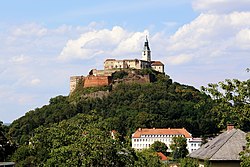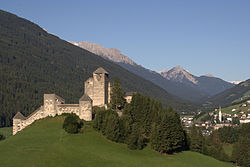| Castle Laudegg | |
|---|---|
Burg Laudegg | |
| Tyrol, Austria Near Ladis in Austria | |
 From Ladis | |
| Site information | |
| Type | Castle |
| Open to the public | Yes (In the months of July and August) |
| Condition | Restored |
| Location | |
| Coordinates | 47°4′34.5″N10°39′9.5″E / 47.076250°N 10.652639°E |
| Site history | |
| Built | 13th Century |
| In use | 13th-16th Century |
| Materials | Slate |
| Events | Appenzell Wars |
Burg Laudegg is a restored castle ruin near the three villages of Ladis, Serfaus, and Fiss, Bezirk Landeck, in the state of Tyrol, Austria. [1] Across the Oberinntal valley lies Castle Berneck at Kauns.










